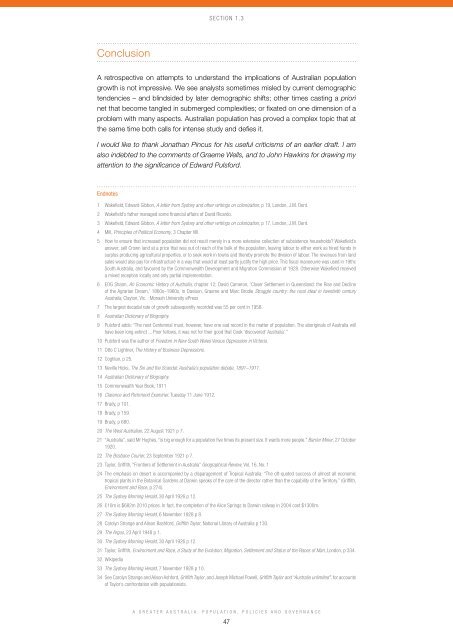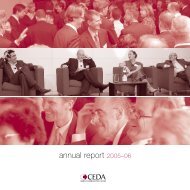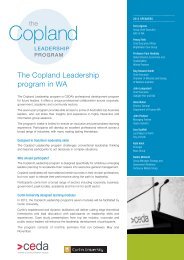Section 1.3ConclusionA retrospective on attempts to underst<strong>and</strong> the implications of <strong>Australia</strong>n populationgrowth is not impressive. We see analysts sometimes misled by current demographictendencies – <strong>and</strong> blindsided by later demographic shifts; other times casting a priorinet that become tangled in submerged complexities; or fixated on one dimension of aproblem with many aspects. <strong>Australia</strong>n population has proved a complex topic that atthe same time both calls for intense study <strong>and</strong> defies it.I would like to thank Jonathan Pincus for his useful criticisms of an earlier draft. I amalso indebted to the comments of Graeme Wells, <strong>and</strong> to John Hawkins for drawing myattention to the significance of Edward Pulsford.Endnotes1 Wakefield, Edward Gibbon, A letter from Sydney <strong>and</strong> other writings on colonization, p 19, London, J.M. Dent.2 Wakefield’s father managed some financial affairs of David Ricardo.3 Wakefield, Edward Gibbon, A letter from Sydney <strong>and</strong> other writings on colonization, p 17, London, J.M. Dent.4 Mill, Principles of Political Economy, 3 Chapter VIII.5 How to ensure that increased population did not result merely in a more extensive collection of subsistence households? Wakefield’sanswer: sell Crown l<strong>and</strong> at a price that was out of reach of the bulk of the population, leaving labour to either work as hired h<strong>and</strong>s insurplus producing agricultural properties, or to seek work in towns <strong>and</strong> thereby promote the division of labour. The revenues from l<strong>and</strong>sales would also pay for infrastructure in a way that would at least partly justify the high price. This fiscal manoeuvre was used in 19thcSouth <strong>Australia</strong>, <strong>and</strong> favoured by the Commonwealth Development <strong>and</strong> Migration Commission of 1928. Otherwise Wakefield receiveda mixed reception locally <strong>and</strong> only partial implementation.6 EOG Shann, An Economic History of <strong>Australia</strong>, chapter 12; David Cameron, ‘Closer Settlement in Queensl<strong>and</strong>: the Rise <strong>and</strong> Declineof the Agrarian Dream,’ 1860s–1960s, in Davison, Graeme <strong>and</strong> Marc Brodie Struggle country: the rural ideal in twentieth century<strong>Australia</strong>, Clayton, Vic. : Monash University ePress7 The largest decadal rate of growth subsequently recorded was 55 per cent in 1958.8 <strong>Australia</strong>n Dictionary of Biography.9 Pulsford adds: “The next Centennial must, however, have one sad record in the matter of population. The aboriginals of <strong>Australia</strong> willhave been long extinct ... Poor fellows, it was not for their good that Cook ‘discovered’ <strong>Australia</strong>’.”10 Pulsford was the author of Freedom in New South Wales Versus Oppression in Victoria.11 Otto C Lightner, The History of Business Depressions.12 Coghlan, p 25.13 Neville Hicks, The Sin <strong>and</strong> the Sc<strong>and</strong>al: <strong>Australia</strong>’s population debate, 1891–1911.14 <strong>Australia</strong>n Dictionary of Biography.15 Commonwealth Year Book, 191116 Clarence <strong>and</strong> Richmond Examiner, Tuesday 11 June 1912.17 Brady, p 101.18 Brady, p 159.19 Brady, p 680.20 The West <strong>Australia</strong>n, 22 August 1921 p 7.21 “<strong>Australia</strong>”, said Mr Hughes, “is big enough for a population five times its present size. lt wants more people.” Barrier Miner, 27 October1920.22 The Brisbane Courier, 23 September 1921 p 7.23 Taylor, Griffith, “Frontiers of Settlement in <strong>Australia</strong>” Geographical Review, Vol. 16, No. 124 The emphasis on desert is accompanied by a disparagement of Tropical <strong>Australia</strong>: “The oft-quoted success of almost all economictropical plants in the Botanical Gardens at Darwin speaks of the care of the director rather than the capability of the Territory.” (Griffith,Environment <strong>and</strong> Race, p 274).25 The Sydney Morning Herald, 30 April 1926 p 12.26 £10m is $682m 2010 prices. In fact, the completion of the Alice Springs to Darwin railway in 2004 cost $1300m.27 The Sydney Morning Herald, 6 November 1928 p 8.28 Carolyn Strange <strong>and</strong> Alison Bashford, Griffith Taylor, National Library of <strong>Australia</strong> p 130.29 The Argus, 23 April 1948 p 1.30 The Sydney Morning Herald, 30 April 1926 p 12.31 Taylor, Griffith, Environment <strong>and</strong> Race, a Study of the Evolution, Migration, Settlement <strong>and</strong> Status of the Races of Man, London, p 334.32 Wikipedia33 The Sydney Morning Herald, 7 November 1928 p 10.34 See Carolyn Strange <strong>and</strong> Alison Ashford, Griffith Taylor, <strong>and</strong> Joseph Michael Powell, Griffith Taylor <strong>and</strong> “<strong>Australia</strong> unlimited”, for accountsof Taylor’s confrontation with populationists.A <strong>Greater</strong> <strong>Australia</strong>: <strong>Population</strong>, Policies <strong>and</strong> Governance47
Section 1.335 W.D. Foresyth, The Myth of Open Spaces, p 68.36 See William Coleman, Selwyn Cornish <strong>and</strong> Alf Hagger, Giblin’s Platoon: The Trials <strong>and</strong> Triumphs of the Economist in <strong>Australia</strong>n PublicLife, ANU EPress37 S.J. Butlin, ‘Frederic Benham: 1900–62’, Economic Record 38(83), p 386–388.38 F.C. Benham, ‘The Optimum Size of <strong>Population</strong>’ The Peopling of <strong>Australia</strong>, P.D. Phillips ed, p 254.39 F.C. Benham, ‘The Optimum Size of <strong>Population</strong>’ The Peopling of <strong>Australia</strong>, P.D. Phillips ed, p 257.40 F.C. Benham, The Prosperity of <strong>Australia</strong>: An Economic Analysis.41 This property of the optimum is pointed out by J.D. Pitchford, The Economics of <strong>Population</strong>: An Introduction: at the optimum the averageproduct of labour equals the marginal product, which is what labour is paid in a competitive environment.42 Of course, one could imagine redistributions between factors so that the optimum actually improves all.43 ∂Y/∂N = y(l)−ly’. The right h<strong>and</strong> side is negative if y 0 at the optimum population.Scitovsky, “Two Concepts of External Economics”, Journal of Political Economy, Vol. 62 p.14346 Arthur Smithies, 1938, The future of the <strong>Australia</strong>n <strong>Population</strong>, in <strong>Australia</strong>n <strong>Population</strong>, Sydney, <strong>Australia</strong>n Institute of InternationalAffairs.47 The marginal utility product of potato labour = marginal utility of potatoes* marginal potato product of labour.48 Smithies sophisticates his analysis by allowing for international trade. If all boots were exported for an importable. there would bemarginal utility product of boot export labour that would bear the same general shape as boot marginal utility product of boots labour;but would bend down more sharply on account of a second downward pressure in addition to diminishing marginal utility: the terms oftrade worsen as boot production is increased.49 Peter Karmel, <strong>Population</strong> <strong>and</strong> Policy, p 21.50 Pitchford appears to be the only post 1930s economist who explores it.51 Martin Bell, 1992, ‘Demographic Projections <strong>and</strong> Forecasts in <strong>Australia</strong>: a Directory <strong>and</strong> Digest”, <strong>Australia</strong>n Government PublishingService.52 SH Wolstenholme, ‘The Future of <strong>Australia</strong>n <strong>Population</strong>:’ Economic Record 12 (23), p 195–213.53 W.D. Borrie, 1947 A White <strong>Australia</strong>: <strong>Australia</strong>’s <strong>Population</strong> Problem. That WD Borrie, “the founder of <strong>Australia</strong>n demography” entitledthis volume A White <strong>Australia</strong>: <strong>Australia</strong>’s <strong>Population</strong> Problem is another reminder that the European ethnicity of <strong>Australia</strong>’s populationwas almost universally treated as a policy parameter in this period. It is the rarity of the exceptions that are interesting: Griffith Taylorrecommending the “mingling” of white <strong>Australia</strong>n population with Asians, <strong>and</strong> FW Eggleston’s 1937 remark that “a mixture of races ison the whole good”.54 A more measured pessimism about fertility in post-War <strong>Australia</strong> is found in Peter Karmel, ‘<strong>Population</strong> Replacement – <strong>Australia</strong>,Economic Record 25 (49) 83–88.55 In 1971 John Coulter (<strong>Australia</strong>n Democrat Senator 1987–1995) explained: ‘Why is it that population cannot continue to exp<strong>and</strong>indefinitely? Quite simply the planet earth is finite <strong>and</strong> at our present rate in a few hundred years there will be st<strong>and</strong>ing room only, onlya few hundred years after that the heat radiated by human bodies would raise the temp of the earth surface to that of molten iron.”<strong>Population</strong>, the main polluter: condensed papers symposium, <strong>Australia</strong>n <strong>and</strong> New Zeal<strong>and</strong> Association for the Advancement of Science,South <strong>Australia</strong>n Division56 K.D Cocks, People Policy: <strong>Australia</strong>’s <strong>Population</strong> Choices, <strong>and</strong> Mark O’Connor, This tired brown l<strong>and</strong>. Doug Cocks stated: “<strong>Population</strong>growth will reduce per capita share/access to those unique natural goods, like snow-fields, beaches <strong>and</strong> recreational rivers, which noteven the most prosperous economy can create.”57 Steve Vizard, Hugh J. Martin <strong>and</strong> Tim Watts, <strong>Australia</strong>’s <strong>Population</strong> Challenge.A <strong>Greater</strong> <strong>Australia</strong>: <strong>Population</strong>, Policies <strong>and</strong> Governance48
- Page 2 and 3: A Greater Australia:Population, pol
- Page 4 and 5: ContentsForeword CEDA Chief Executi
- Page 6 and 7: ForewordIt is with pleasure that I
- Page 8 and 9: IntroductionResponding to the resul
- Page 10 and 11: IntroductionA more dynamic and vita
- Page 12 and 13: IntroductionSustainabilityConcern a
- Page 14 and 15: IntroductionThe new demographics, h
- Page 16 and 17: Section 1.0Historical perspectives1
- Page 18 and 19: Section 1.1IntroductionJapan’s cr
- Page 20 and 21: Section 1.1Figure 1Forecast number
- Page 22 and 23: Section 1.1Table 1Defence spending
- Page 24 and 25: Section 1.1How much defence is enou
- Page 26 and 27: Section 1.1ConclusionA substantial
- Page 28 and 29: Section 1.2There has been over a ce
- Page 30 and 31: Section 1.2Resource constraints wer
- Page 32 and 33: Section 1.2Similarly, in the 1994 H
- Page 34 and 35: Section 1.2ReferencesAustralia, Dep
- Page 36 and 37: Section 1.3IntroductionAustralia is
- Page 38 and 39: Section 1.3The grey 90sThe heady ex
- Page 40 and 41: Section 1.3Taylor’s stony rebutta
- Page 42 and 43: Section 1.3Figure 1The Benhamite Op
- Page 44 and 45: Section 1.3In mathematical terms, t
- Page 46 and 47: Section 1.3characterisation of the
- Page 50 and 51: Section 2.0Population futures2.1 Fo
- Page 52 and 53: Section 2.1Conventional population
- Page 54 and 55: Section 2.1It is more useful for go
- Page 56 and 57: Section 2.1Forecasting of births, w
- Page 58 and 59: Section 2.1Future net overseas migr
- Page 60 and 61: Section 2.13). This had a lot to do
- Page 62 and 63: Section 2.2IntroductionIn late Sept
- Page 64 and 65: Section 2.2Figure 1The migrant cont
- Page 66 and 67: Section 2.2The visa and residency s
- Page 68 and 69: Section 2.2sponsorship, subject to
- Page 70 and 71: Section 2.2Figure 3Historical and p
- Page 72 and 73: Section 2.2The views in this chapte
- Page 74 and 75: Section 2.3IntroductionThe Australi
- Page 76 and 77: Section 2.3Figure 3Australia: Distr
- Page 78 and 79: Section 2.3Table 2Australia: Popula
- Page 80 and 81: Section 2.3Table 4Views of Australi
- Page 82 and 83: Section 2.3Table 5Australian States
- Page 84 and 85: Section 2.3A number of hypotheses h
- Page 86 and 87: Section 2.3Table 8Australia: Distri
- Page 88 and 89: Section 2.3Table 10Non-Metropolitan
- Page 90 and 91: Section 2.3Policy issuesThe configu
- Page 92 and 93: Section 2.3Climate change is likely
- Page 94 and 95: Section 2.3ConclusionAny realistic
- Page 96 and 97: Section 2.340 Swan, W., 2010.Austra
- Page 98 and 99:
Section 2.4IntroductionThe Australi
- Page 100 and 101:
Section 2.4At present there is a hi
- Page 102 and 103:
Section 2.4innovation initiatives w
- Page 104 and 105:
Section 2.4Endnotes1 Henry, K 2009,
- Page 106 and 107:
Section 2.5IntroductionAustralia is
- Page 108 and 109:
Section 2.5else. Even with a broad
- Page 110 and 111:
Section 2.5commercially viable - th
- Page 112 and 113:
Section 2.5A vast country like Aust
- Page 114 and 115:
Section 3.0Society and the individu
- Page 116 and 117:
Section 3.1Extent of public opinion
- Page 119 and 120:
Section 3.1category immigrant/forei
- Page 121 and 122:
Section 3.1The Environics Research
- Page 123 and 124:
Section 3.1Per cent100908070Figure
- Page 125 and 126:
Section 3.1A number of surveys soug
- Page 127 and 128:
Section 3.1Table 8Percentage who an
- Page 129 and 130:
Section 3.1A more precise indicatio
- Page 131 and 132:
Section 3.1The strongest predictor
- Page 133 and 134:
Section 3.1Endnotes1. There is also
- Page 135 and 136:
3.2Social inclusion and multicultur
- Page 137 and 138:
Section 3.2a broader definition of
- Page 139 and 140:
Section 3.2Figure 1Estimated povert
- Page 141 and 142:
Section 3.2Table 2Visa Type of Sett
- Page 143 and 144:
Section 3.2Table 5First Generation
- Page 145 and 146:
Section 3.2Table 6Australia: First
- Page 147 and 148:
Section 3.2Improving outcomes for v
- Page 149 and 150:
Section 3.2increasing diversity of
- Page 151 and 152:
3.3Linkages between education and p
- Page 153 and 154:
Section 3.3Education and productivi
- Page 155 and 156:
Section 3.3In the past decade, prod
- Page 157 and 158:
Section 3.3succeed in education or
- Page 159 and 160:
Section 3.3case, funding also could
- Page 161 and 162:
Section 3.3Endnotes1 IGR 2010: Chal
- Page 163 and 164:
3.4Healthcare delivery for our agei
- Page 165 and 166:
Section 3.4• Private medical serv
- Page 167 and 168:
Section 3.4the whole spectrum of in
- Page 169 and 170:
Section 3.45. Experiences, pathways
- Page 171 and 172:
Section 3.4Stratification of patien
- Page 173 and 174:
Section 3.4Other steps include impr
- Page 175 and 176:
Section 3.438 National Health Refor
- Page 177 and 178:
4.1The economic effects ofpopulatio
- Page 179 and 180:
Section 4.1population growth can ex
- Page 181 and 182:
Section 4.1In theory, the answer pa
- Page 183 and 184:
Section 4.1Kirchner concedes that t
- Page 185 and 186:
Section 4.1Endnotes1. Productivity
- Page 187 and 188:
4.2Urban infrastructure and land us
- Page 189 and 190:
Section 4.2bearing the fixed costs
- Page 191 and 192:
Section 4.2Figure 1Indicative dwell
- Page 193 and 194:
Section 4.2Taking the electricity,
- Page 195 and 196:
Section 4.2Promoting better land us
- Page 197 and 198:
Section 4.2preferences to homeowner
- Page 199 and 200:
Section 4.2in any Australian urban
- Page 201 and 202:
Section 4.2Endnotes1 Productivity C
- Page 203 and 204:
4.3Water security:Water for the far
- Page 205 and 206:
Section 4.3Water trading enables us
- Page 207 and 208:
Section 4.3cent of water entitlemen
- Page 209 and 210:
Section 4.3were either the full eco
- Page 211 and 212:
Section 4.3Strategic opportunitiesA
- Page 213 and 214:
4.4Critiquing governmentregional de
- Page 215 and 216:
Section 4.4However, there is often
- Page 217 and 218:
Section 4.4Potential policy interve
- Page 219 and 220:
Section 4.4Unfortunately, advocacy
- Page 221 and 222:
Section 4.4contribute substantially
- Page 223 and 224:
Section 4.418 Department of Educati
- Page 225 and 226:
5.1The future of population policyG
- Page 227 and 228:
Section 5.1a million fewer women in
- Page 229 and 230:
Section 5.1For the present, ongoing
- Page 231 and 232:
Section 5.1The second worry is that
- Page 233 and 234:
Section 5.1The now significantly de





